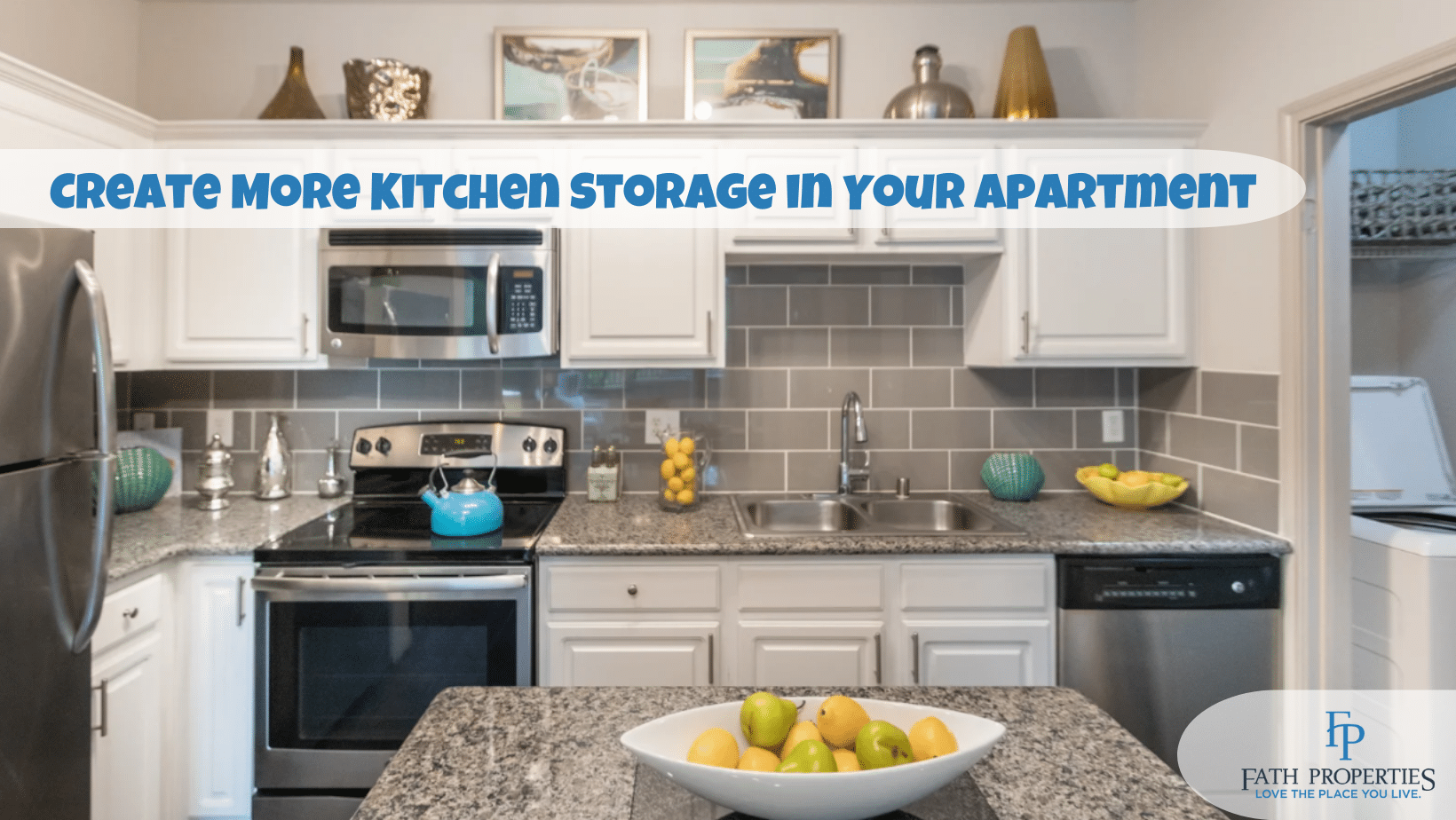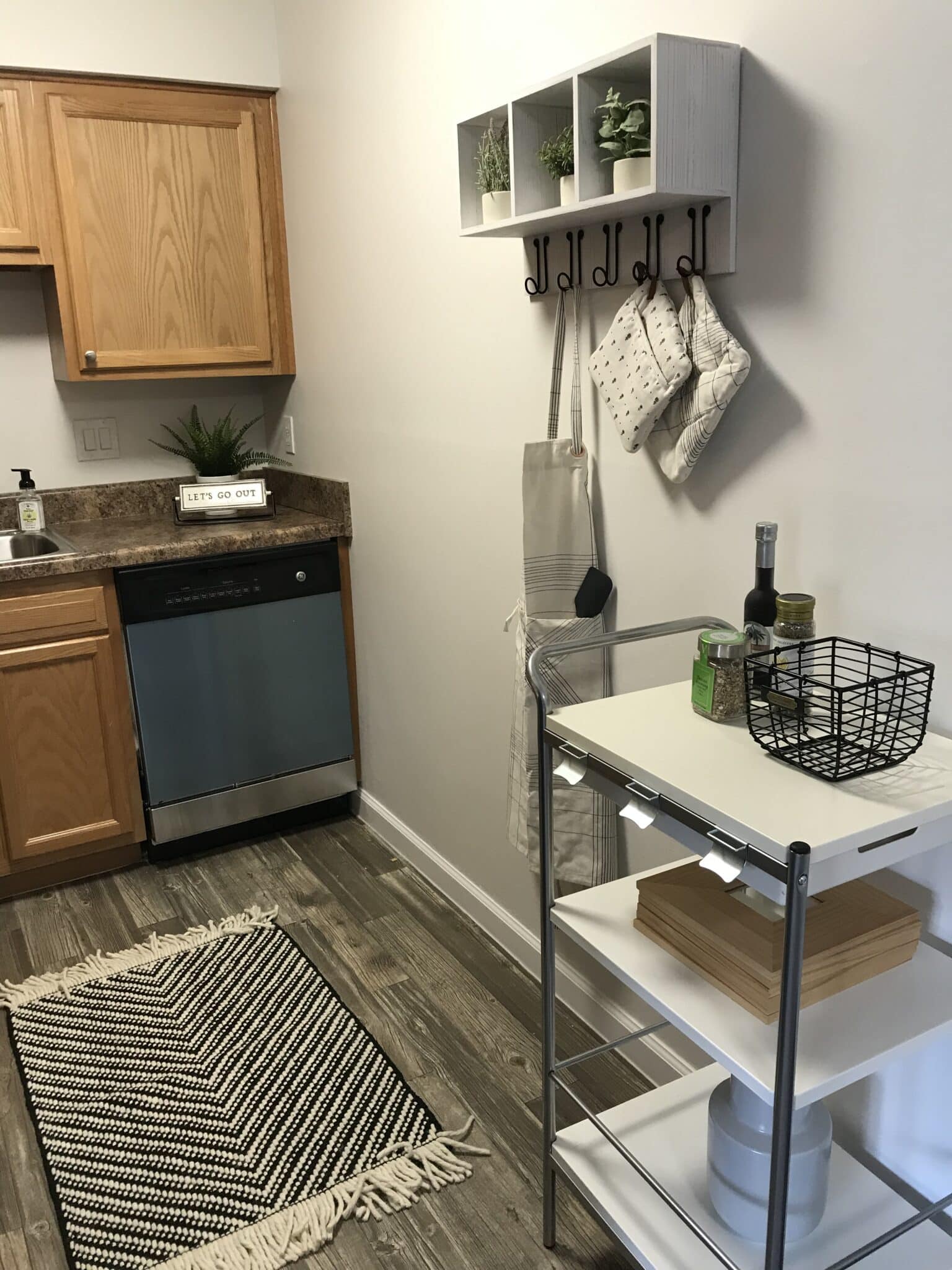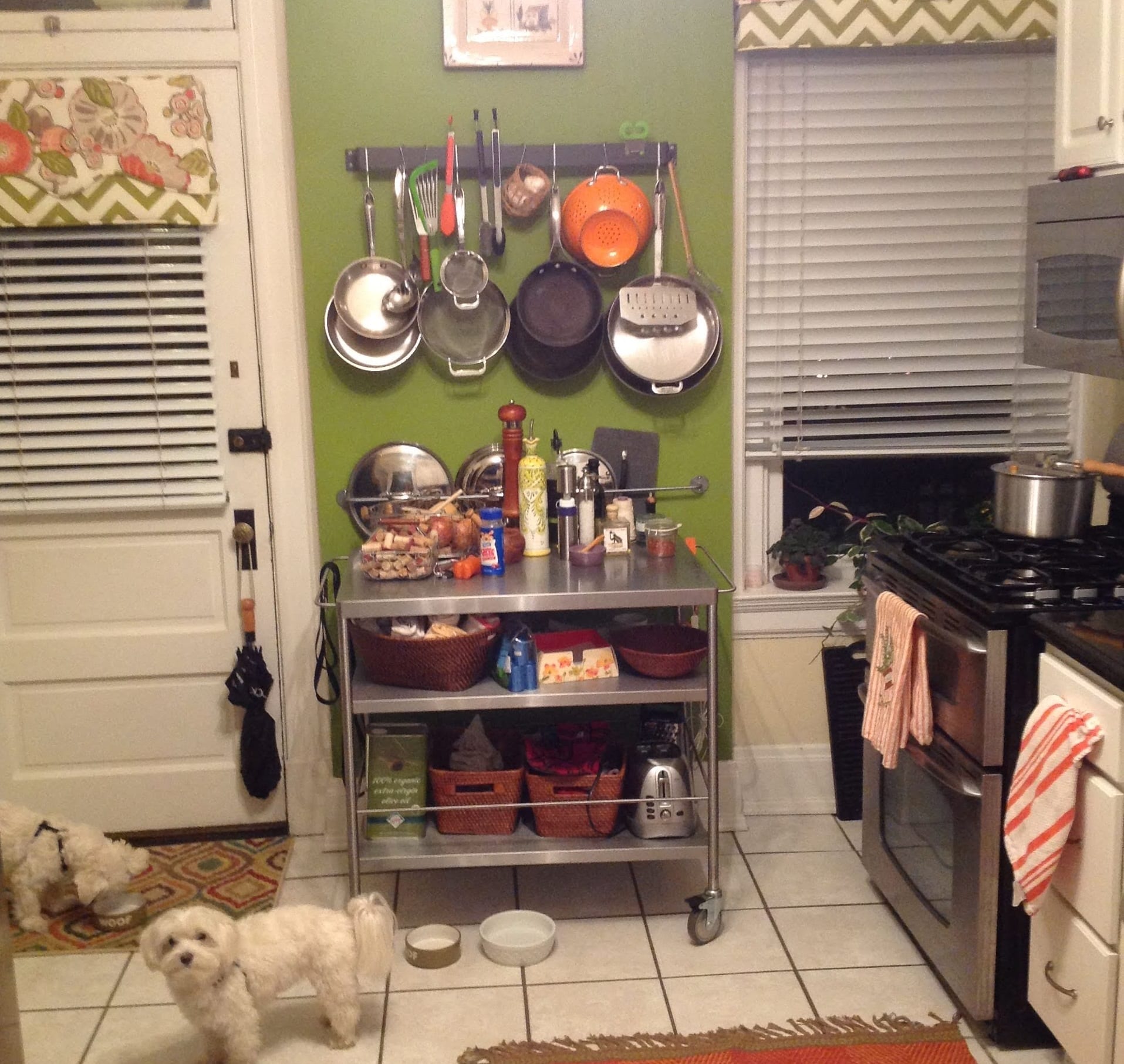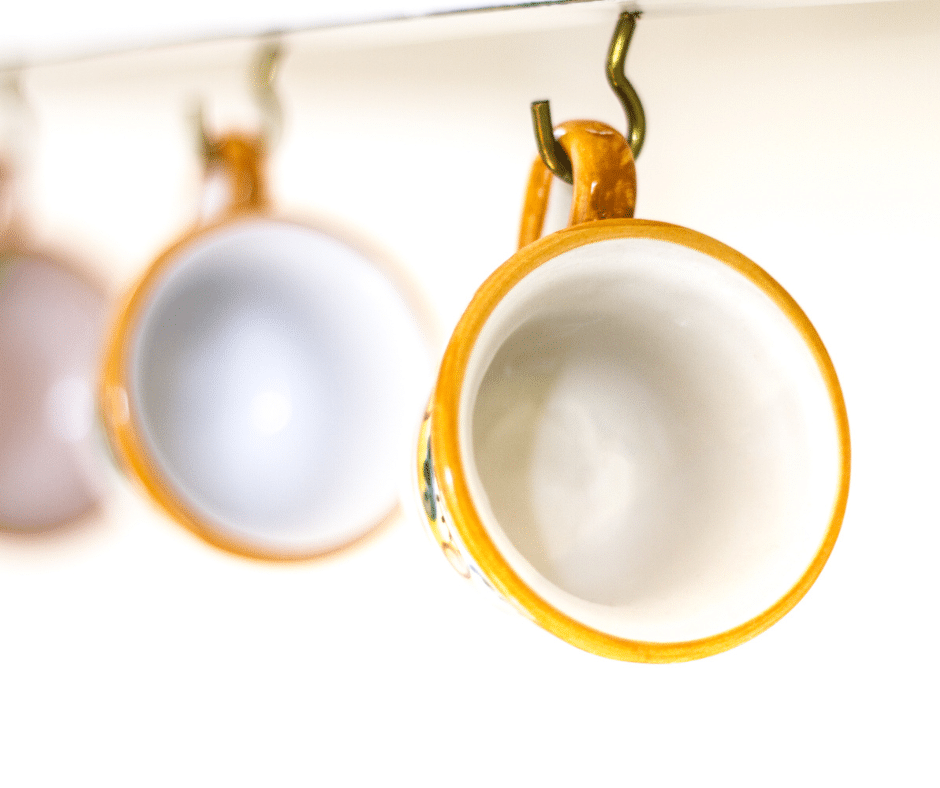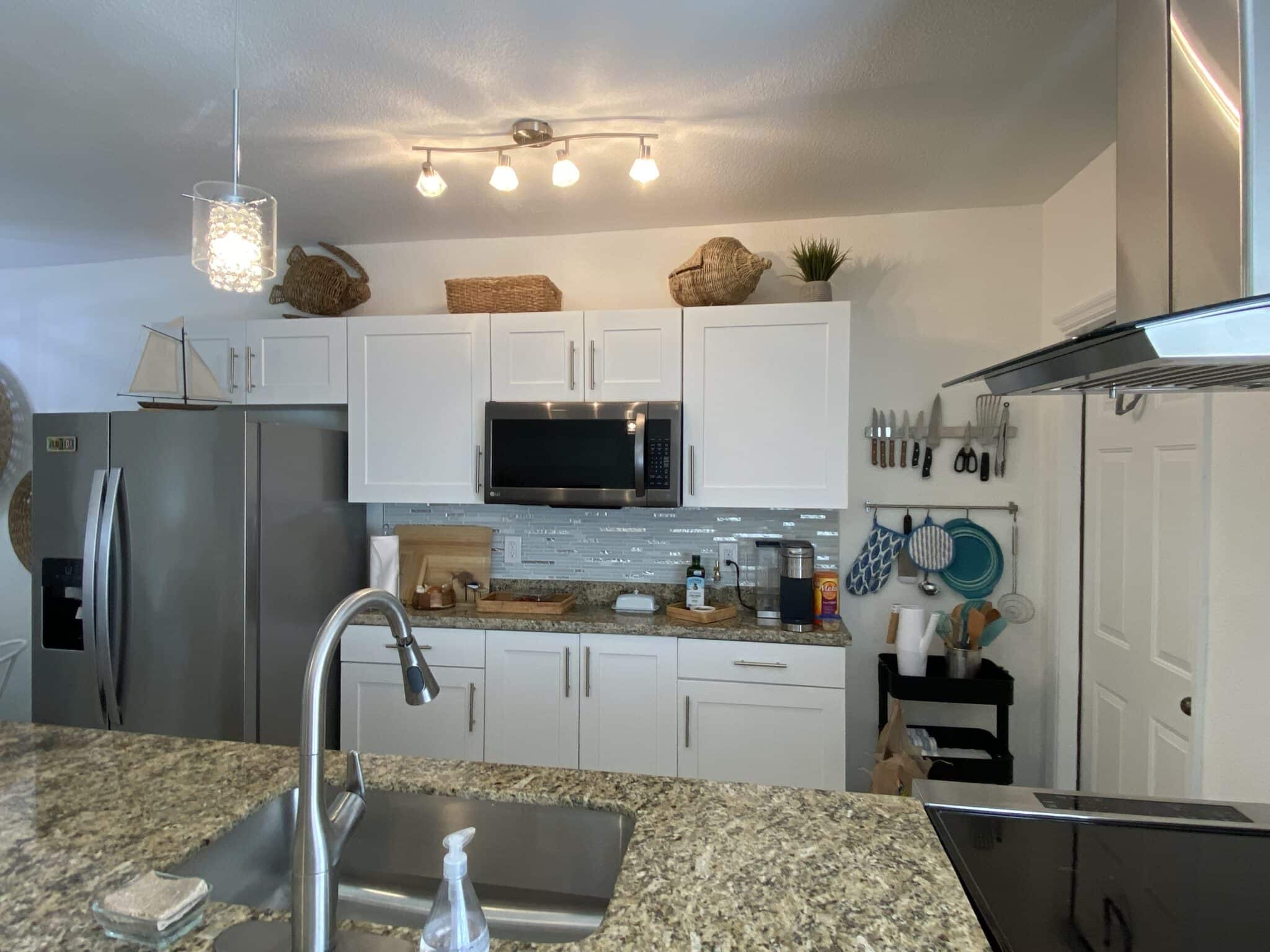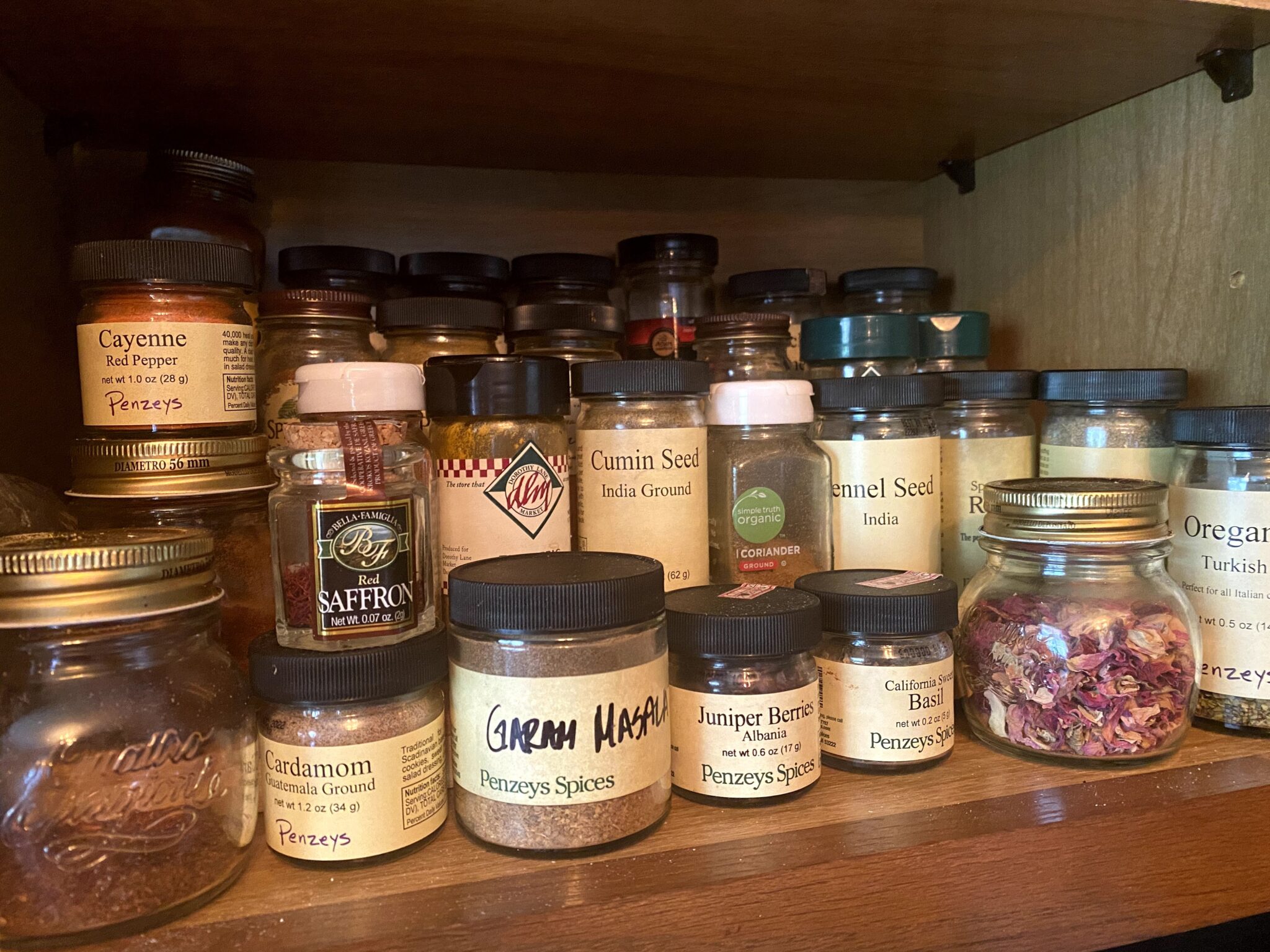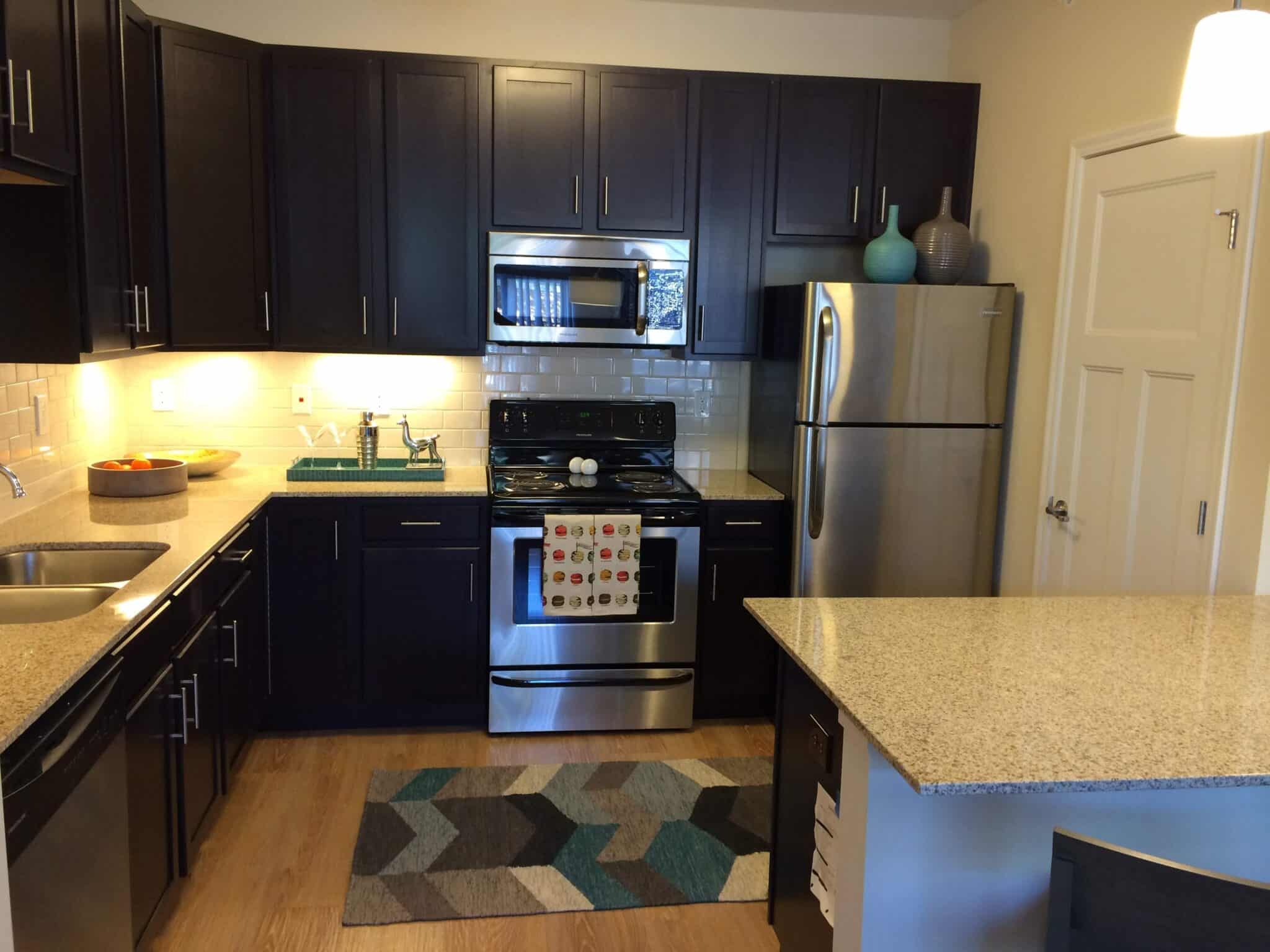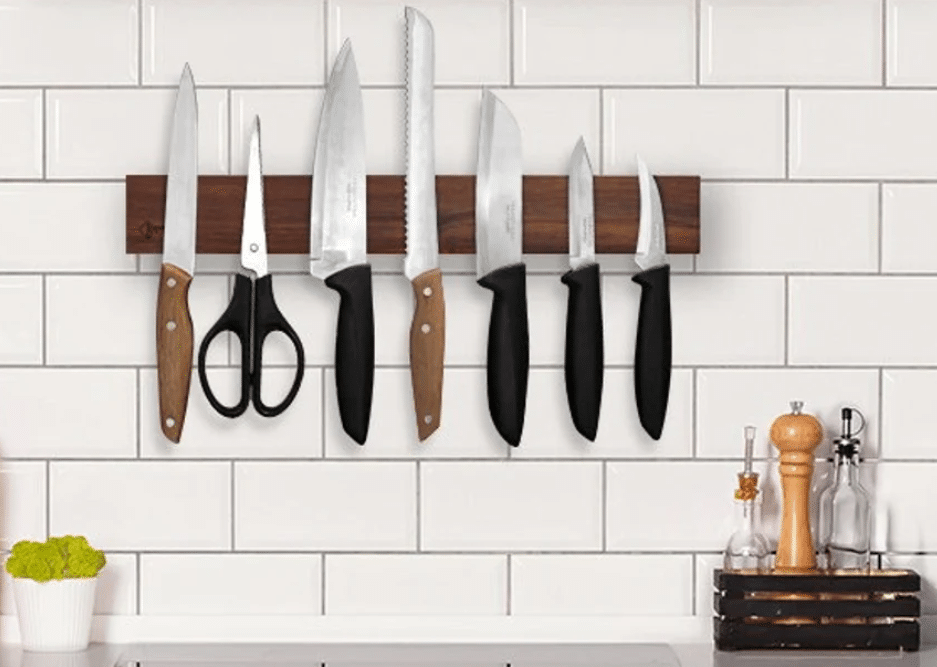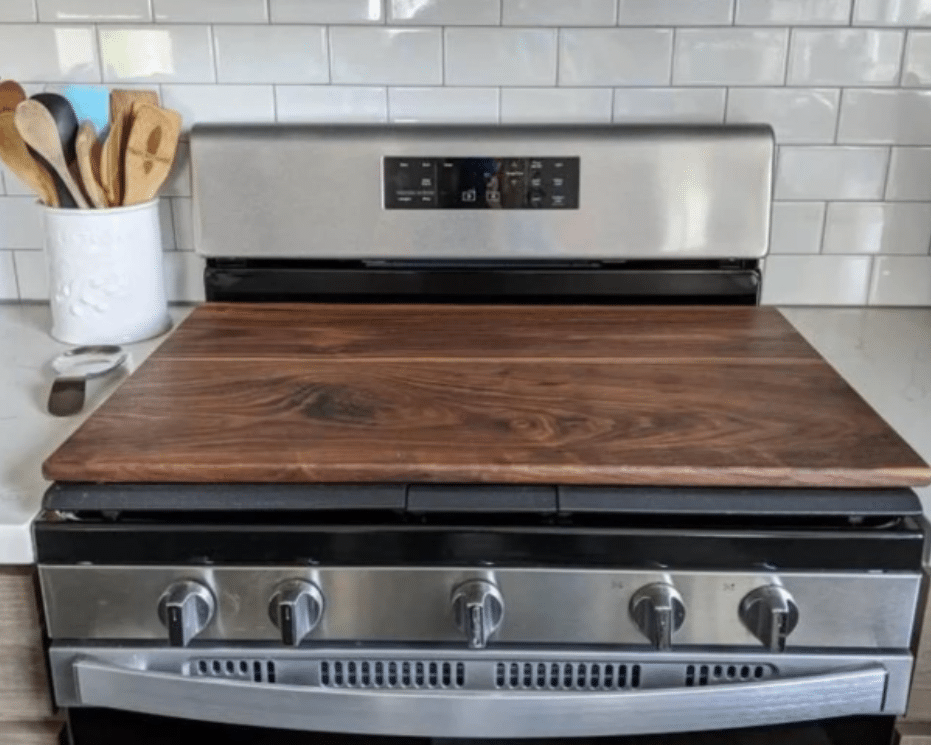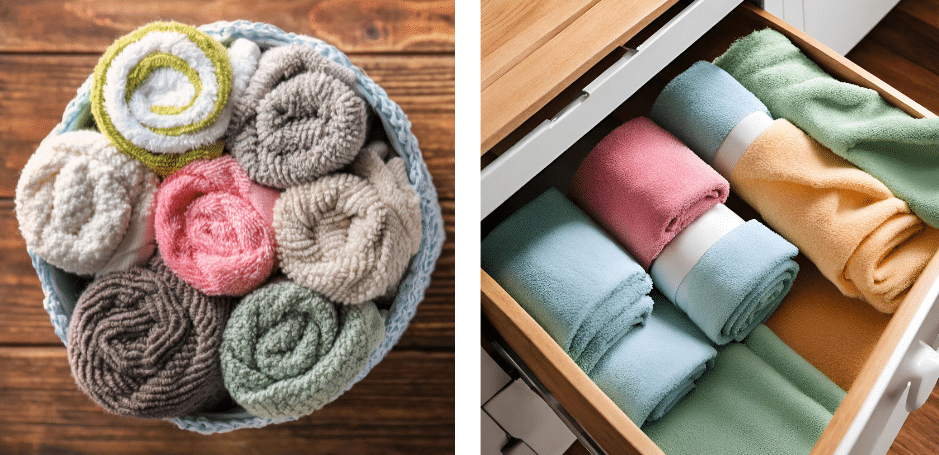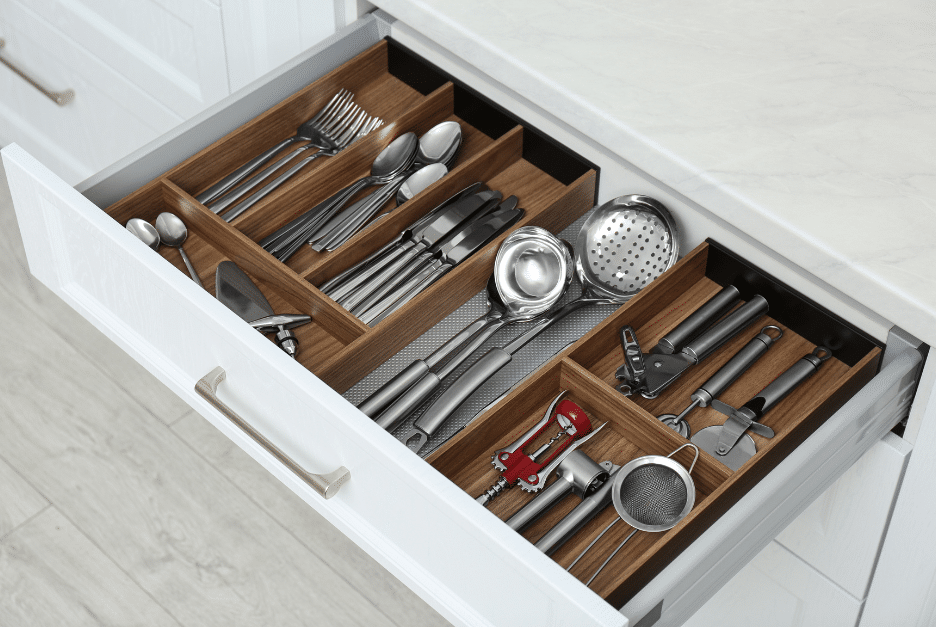When she was in college, I helped my daughter move into her first non-dorm apartment in the Bushwick neighborhood of Brooklyn. It was a cute studio apartment with one (albeit huge) window, a living/sleeping area, a bathroom, and a kitchen. But I was shocked to the core by how incredibly small her kitchen was. There was a refrigerator, a single bowl sink, and the tiniest stove I’d ever seen. The entire kitchen is pictured below.
Of course, it never seems we have enough storage no matter how much space we actually have (at least that’s always the case with me. LOL.). So if you’re like me, always needing more storage, here are some ways to create more kitchen storage in your apartment.
Use shelf risers.
Shelf risers can almost double your cabinet and pantry storage space. Bonus: they’re not super expensive. Use them to store extra plates, bowls, glasses, and mugs in your cabinets; and canned goods in your pantry.
Steal space from an adjoining room.
An alcove, nook, or empty wall in an adjacent room or hallway can be a great spot to add some shelves or a storage unit.
Add a utility cart.
A little wheeled utility cart can work wonders to give you a little more space. You can tuck it under a countertop or hide it inside a lesser-used closet when you need the floor space more than the stuff. A narrow shelf or rolling storage cart can be a stylish and practical addition to a small kitchen. Choose a low-profile design that can easily slide against a wall or into a corner. Stock it with dishes, glassware, and other items that will look good on display.
Check out IKEA’s Raskog cart or this narrow cart from Amazon. They are small but still have plenty of room for storage. And because they’re on wheels, they can be pushed into a closet or the corner of a room and pulled out to meet you at your workspace when you need it.
Hang a pegboard.
Think Julia Child’s kitchen. A pegboard creates about as much damage to your wall as hanging a picture. You can use a pegboard to store a myriad of items from utensils to awkwardly large pots and pans with specially designed accessories. You’ll just need to spackle the holes before you move (here’s how). A pegboard is a simple storage solution that can work wonders in a small kitchen. Affix a pegboard with repositionable hooks to a wall or the inside of a tall cabinet door to hang kitchen supplies. As your storage needs change, simply remove and rearrange the hooks to efficiently store cookware, utensils, and so much more.
Hang a curtain rod or pot rack.
Use a small curtain rod to hang your utensils (with S hooks or just hooked on), and slide the lids of your pots and pan behind it. This will free up a surprising amount of space for other things (and there will always be other things). A pot rack or a sturdy bar can provide handy storage for all types of cookware. Mount it on a wall next to the prep area or directly above the cooktop so pots and pans are easily within reach. A mounted pot rack really helps save cabinet space and makes items easier to access. If you have limited wall space, a helpful small kitchen decor idea is to hang the rack from the ceiling or over a window.
Use adhesive hooks.
Use adhesive wall-mount hooks (like Command Hooks) to hang items that would otherwise take up space on the counter or in a drawer. A set of hooks make a great kitchen catchall adding valuable kitchen storage space. Use them for kitchen towels, cutting boards, and utensils to keep them out of the way but still within arm’s reach.
Screw hooks under cabinets.
Cup hooks screwed into the bottom of cabinets can create a cute way to hang up mugs, utensils, and other smaller items. Or you can find cup hooks like these that simply slide into place.
Use the sides of your cabinets.
Put the sides of your cabinets to good use in creating more storage in your kitchen. It’s the perfect spot to hang a magnetic knife block or use adhesive hooks to hang smaller pots and kitchen tools.
Use the tops of cabinets.
If you have space between the top of your cabinets and the ceiling, you can store less frequently items on the tops of your cabinets without making them look cluttered or messy. This gap between your cabinets and the ceiling can be critical in creating additional storage space. Think of a crockpot, a wine rack, or baskets filled with unattractive but necessary items like light bulbs and batteries. I know what some of you are thinking: “But I’m too short to store stuff this high!” A fold-flat stool you can tuck in between your fridge and cabinets will solve this worry!
Use the side of your fridge.
The side of your fridge can be the perfect spot for knife storage or spice storage, using magnetic racks. It’s an ideal spot to tack up grocery lists, hang keys, or sort mail and papers.
Install open shelving.
Create additional kitchen storage beyond your cabinets by installing open shelves. This simple project can transform a blank stretch of a wall into a stylish storage zone for dishware, cookbooks, pantry ingredients, and more. For extra organizing capacity, add hooks along the bottom of a shelf where you can hang mugs or utensils.
Divide cabinet space.
Encourage organization in smaller kitchens with dividers that break up the space inside cabinets. Use either horizontal or vertical cabinet dividers to store skillets, baking sheets, and narrow pans. You can simply slide each one out of its individual slot instead of having to sort through a haphazard stack.
Rethink spice storage.
Small containers of spices and herbs can easily become a jumbled mess inside a cabinet or pantry. To streamline access, dedicate a small drawer or sliver of cabinet space to spice storage. A drawer organizer that holds canisters in an upright position is an optimal storage solution for easy reading. Read our blog dedicated to storing spices here.
Install a small kitchen island.
Squeeze extra prep and storage space into a small kitchen with an island or kitchen cart that’s just the right size and height for your needs. Add-ons such as hooks and bins will help a small island work even harder. If space is especially tight, go with an island on casters to get the look of a built-in without the bulk. During cleanup or while entertaining, just roll the workspace out of the way.
Select small kitchen appliances.
Small appliances are essential to the kitchen, especially when it comes to entertaining and preparing last-minute meals on busy weeknights. Small appliances that pull double-duty, such as a combination air fryer, toaster, and convection oven, will save kitchen space.
Use wall-mounted bins.
A wall-mounted storage system allows a small kitchen to be the administrative hub that it is without taking up floor space. Choose metal bins that match the kitchen color scheme, and add storage labels to make them more functional. This would be a great place to store cooking magazines, bills (UGH), notepads, and the like.
Use windowsills as storage.
If you’re lucky enough to have a window in your kitchen, think about how you can use the sill as storage. Bring the outdoors in by adding plants – perhaps an herb garden, store cookbooks (if the window is not above the sink), or a dishwashing supply station (if the window is above the sink).
Use your windows as storage.
You might never dream of blocking any of that precious natural light, but you could hang your pots and pans in front of your kitchen window. This would also be an ideal spot for a hanging herb garden.
Use the top of your fridge.
The top of the fridge is a great place to store cookbooks, trays, and platters, or baskets filled with items like light bulbs and batteries, or dishtowels.
Hang a magnetic knife rack.
My fella thinks I’m nuts (because he sees threats everywhere LOL), but I love my wall knife rack. When drawer space is at a premium, every square inch counts (and I honestly see more of a threat storing sharp knives in a drawer). Squeeze out a bit more room by taking your cutlery to the walls with a magnetic knife strip. You can even use it to hang things that aren’t knives, like metal utensils.
Use the inside of cabinet and pantry doors.
A perfect spot to hang pot lids, pot holders, measuring spoons, and kitchen towels.
Turn your stovetop into extra counter space.
During dinner prep, your stovetop is just wasted space. A large cutting board creates bonus counter space while you are prepping dinner.
Hide bulky cookware in the oven.
It sounds simple, but if you’ve got a lot of heavy cookware, this trick can make all the difference. It’s a great place to store cast-iron pans and Dutch ovens (especially in a small kitchen). Just remember to relocate them before you preheat that oven.
Hang sink essentials on the sink.
Sink organizers are a total game-changer for storing soaps, sponges, and brushes where you can easily access them. Place them over your sink, next to them, or even attach them and hang them off the faucet for a space-saving way to keep essentials close.
Roll kitchen towels.
Marie Kondo your kitchen towels by rolling them instead of folding and stacking them into a toppling tower. Roll then lay them horizontally in a shallow drawer, or store them in upright rolls in a basket. They look much tidier this way—and don’t become a nuisance every time you need one.
Store canned foods on risers.
Canned foods often get tucked away in a cupboard, stacked on one another, and pushed way to the back. Instead of losing sight of all those cans, place them on risers so you can actually see what you have. An easy way to gain vertical storage is to add risers to pantries and cabinets. They help you fit more in a small space, plus you can see what you have so you don’t end up with a bunch of duplicates.
Use drawer separators.
There is nothing worse than a utensil or small tool drawer that’s messy with everything scattered about. It makes it harder to find what you’re looking for and easier to poke yourself with one of the tools. Drawer separators keep groupings, like utensils, together and are easy to sort through.
Be sure to evaluate your needs as you install the dividers, edit, and toss the duplicates. Sure it’s awesome to have multiple spatulas and non-stick skillets, but if space is a challenge, push yourself to only have one of each. While that may create a slight inconvenience occasionally, it’s better than having overflowing drawers and cabinets.
By adding dividers, everything has a spot and the drawer is less likely to get stuck on stuffed-in tools.
Under sink storage.
Maximize storage space under the sink by stacking bins or plastic drawers filled with sponges, dishwasher pods, rags, and more. Clear storage assures you won’t forget about what you already have. It’s also a great idea to have a plastic tray to store your cleaning supplies in. That way, if anything gets drippy, you just have to clean the tray and not risk warping the floor of the cabinet.
So there you have it. Who knew there were so many ways to create additional storage in any kitchen – large or small? We’d love to hear if you have any other ways to add storage to your kitchen! Let us know in the comments.
